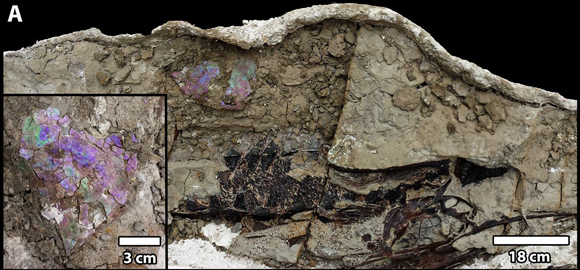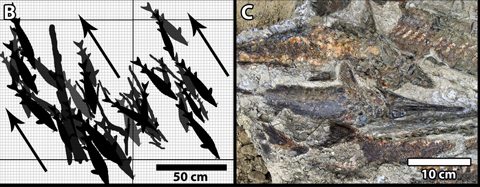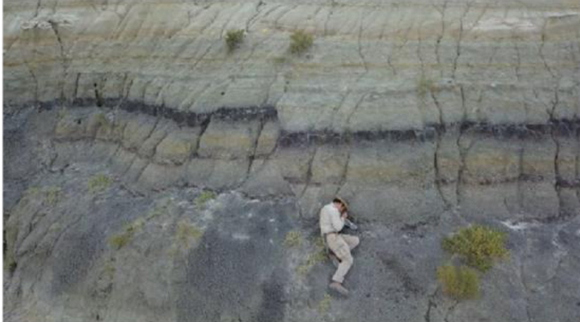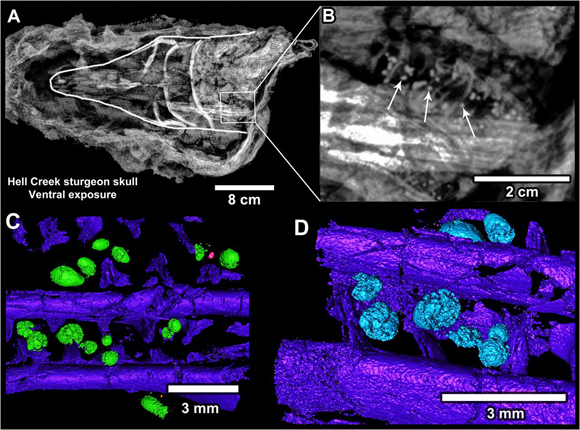Fossil Discovery Offers Detailed View Minutes After Chicxulub Impact
A paper published in the PNAS (Proceedings of the National Academy of Sciences – USA), provides a detailed snapshot of a terrible natural disaster linked to the Chicxulub bolide impact event. A site (Tanis), in North Dakota’s Upper Cretaceous Hell Creek Formation, records the devastation caused by a massive surge of water which occurred as seismic shockwaves reverberated around the Earth as a result of the huge extra-terrestrial impact in what is now the Gulf of Mexico.
Examining Rock Layers Looking for Evidence
Picture credit: Robert DePalma (University of Kansas)
Tanis Fossil Site – A “Motherlode” of Fossils
A team of palaeontologists, including researchers from the University of Kansas, the Black Hills Institute and Manchester University, in collaboration with a number of other academic institutions report on what has been described as a “motherlode of exquisitely-preserved plant, animal and fish fossils”, the remains of a river ecosystem which flowed into the Western Interior Seaway, which was wrecked within minutes of the extra-terrestrial impact event.
The site is described as a “rapidly emplaced high-energy onshore surge deposit” along the KT boundary that contains associated ejecta and iridium impactite associated with the End Cretaceous extinction event that resulted in the loss of many groups of terrestrial vertebrates including the pterosaurs and the dinosaurs as well as the extinction of a wide variety of marine organisms.
Lead author of the scientific paper, Robert DePalma (University of Kansas), described the Tanis fossil site as:
“A tangle mass of freshwater fish, terrestrial vertebrates, trees, branches, logs, marine ammonites and other marine creatures was all packed into this layer by the inland-directed surge”.
One of the Plaster Jackets from the Site Reveals the Devastation

Picture credit: PNAS
The doctoral student went onto add:
“Timing of the incoming ejecta spherules matched the calculated arrival times of seismic waves from the impact, suggesting that the impact could very well have triggered the surge.”
Devastation Occurred Within Minutes of the Impact
The researchers conclude that the fossil site does not record a tsunami. Tanis is more than 2,000 miles from the bolide impact site in the Gulf of Mexico, a tsunami would have taken at least seventeen hours to reach North Dakota, but seismic waves and a subsequent water surge would have occurred within minutes of the collision.
DePalma and his colleagues describe the rushing wave that shattered the Tanis site as a “seiche.”
What is a Seiche?
A seiche (pronounced “saysh”), relates to a standing wave in an enclosed or part-enclosed body of water. This term was first used widely by the Swiss scientist François-Alphonse Forel (1841-1912), who pioneered the study of inland water ecosystems. It is believed the etymology derives from the Swiss/French dialect meaning “swaying back and forth”, a reference to observations of water level changes in alpine lakes. This phenomenon can have many causes, but seismic activity is known to lead to water surges.
DePalma explained:
“As the 2011 Tohoku earthquake in Japan showed us, seismic shaking can cause surges far from the epicentre. In the Tohoku example, surges were triggered nearly 5,000 miles away in Norway just 30 minutes after impact. So, the KT impact could have caused similar surges in the right-sized bodies of water worldwide, giving the first rapid “bloody nose” to those areas before any other form of aftermath could have reached them.”
According to Kansas University researchers, even before the surge arrived, acipenseriform fish (sturgeon) found at the site already had inhaled tiny spherules ejected from the Chicxulub impact.
Fish Fossils Show Evidence of Microtektites Embedded in Their Gills
Picture credit: PNAS
Microtektites Embedded in Gills
The picture above shows acipenseriform fish with ejecta clustered in the gill region. Image (A) an X-ray of a fossil sturgeon head (outlined, pointing left; FAU.DGS.ND.161.115.T). Magnified image (B) of the X-ray in (A) showing numerous ejecta spherules clustered within the gill region (arrows). Images C and D are micro-CT images of another fish specimen (paddlefish), with microtektites embedded between the gill rakers in the same fashion.
Co-author David Burnham (Kansas University) stated:
“The fish were buried quickly, but not so quickly they didn’t have time to breathe the ejecta that was raining down to the river. These fish weren’t bottom feeders, they breathed these in while swimming in the water column. We’re finding little pieces of ejecta in the gill rakers of these fish, the bony supports for the gills. We don’t know if some were killed by breathing this ejecta, too.”
One of the co-authors of the paper is Californian geologist Walter Alvarez, who, along with is his father Luis, postulated the theory of an impact event playing a role in the End Cretaceous extinction (1980). They identified a layer of sediment in the strata marking the Cretaceous/Palaeogene boundary (KPg), that was enriched with the rare Earth element iridium and they concluded that an extra-terrestrial object must have collided with the Earth.
Described as a Lagerstätte of the KT Event
The number and quality of preservation of the fossils at Tanis are such that Burnham dubs it the “lagerstätte” of the KT event. A lagerstätte, comes from the German “storage place”, it describes a sedimentary deposit that contains a large number of very well preserved fossils. For example, the Tanis site preserves numerous acipenseriform fish, which are cartilaginous and not bony and therefore less likely to become fossils.
David Burnham added:
“The sedimentation happened so quickly everything is preserved in three dimensions, they’re not crushed. It’s like an avalanche that collapses almost like a liquid, then sets like concrete. They were killed pretty suddenly because of the violence of that water. We have one fish that hit a tree and was broken in half.”
Indeed, the Tanis location contains many hundreds of articulated ancient fossil fish killed by the Chicxulub impact’s consequences and is remarkable for the biodiversity it reveals alone.
Mapping the Direction of the Surge and Examining the Fish Fossils

Picture credit: PNAS
Several New Species
The scientists conclude that there are likely to be several new species of fish named as a result of this discovery. In addition, some specimens are the best known examples of their genus found to date. It was quickly realised that the surrounding matrix was deposited by a sudden, violent rush of water, a surge that was directed inland away from the Western Interior Seaway. Impact debris including shocked minerals and ejecta spherules were found in the sediment and a compact layer of KT boundary clay overlies the deposit.
Tanis provides a post impact “snapshot,” including ejecta accretion and faunal mass death, advancing our understanding of the immediate effects of the Chicxulub impact.
According to Burnham, this site will advance our understanding of the Chicxulub impact significantly, describing Tanis as “smoking-gun evidence” of the aftermath.
Everything Dinosaur acknowledges the assistance of a press release from the University of Kansas in the compilation of this article.
The scientific paper: “A Seismically Induced Onshore Surge Deposit at the KPg Boundary, North Dakota” by Robert A. DePalma, Jan Smit, David A. Burnham, Klaudia Kuiper, Phillip L. Manning, Anton Oleinik, Peter Larson, Florentin J. Maurrasse, Johan Vellekoop, Mark A. Richards, Loren Gurche, and Walter Alvarez published in the PNAS.
Visit the award-winning Everything Dinosaur website: Everything Dinosaur.








Leave A Comment